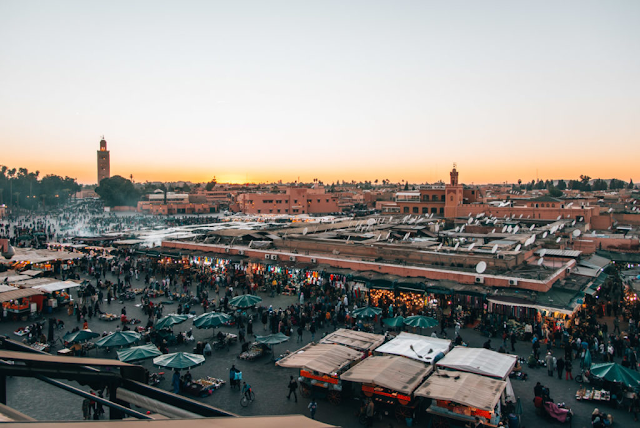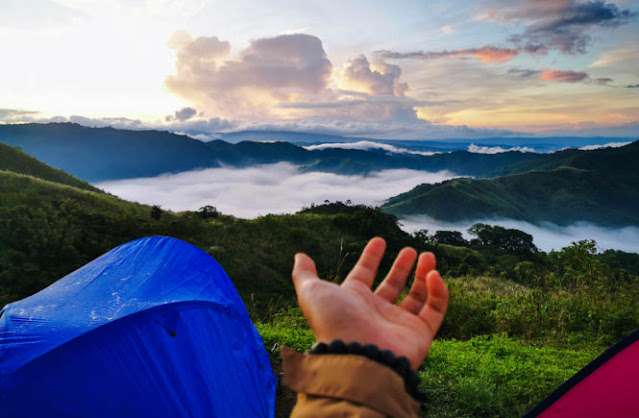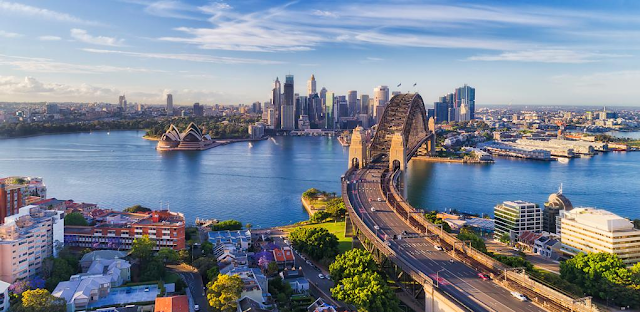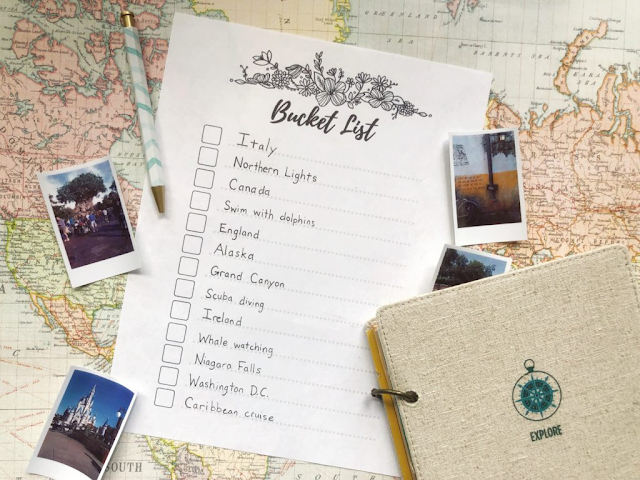Travel Advice and Our Honest Review for Marrakech
Marrakech – Only a four-hour flight separates Marrakech from Europe, but it feels like another planet. Marrakech is a life-filled, bustling city. You'll be captivated and astounded by it. Anyone visiting Marrakech anticipates a dream from the Arabian nights but is swiftly brought back to earth by reality. Why? In this blog post, we will inform you of it.
So if you're seeking for reviews and planning a vacation to Marrakech, you've come to the correct place on our travel site. We give you a tour of Marrakech's most stunning landmarks and features while sharing our insider advice. Are you prepared for a full-on adventure? Move along!
1. Marrakech: Expectations vs. Reality
People either adore or loathe Marrakech. Let's put it this way: we know enough folks who went to Marrakech with really high expectations and came back terribly dissatisfied. Okay, so maybe hatred is exaggerating, but let's put it that way. Simple association between Marrakech and a dream from 1001 Arabian Nights is the most common explanation for this. Unfortunately, the truth is rather different. Let's get a little more into that.
XEM THÊM :
S777 Review Game Bài 88 – Sân Chơi Mới 2022
Marrakech: what REALLY awaits you
Marrakech has one of the highest tourist populations in all of Morocco. The behavior of the locals is such that you cannot even accuse them of it; they are merely looking to maximize their financial gain. You are easily taken advantage of in the souks (the markets). And it is obvious what will happen when you are invited to a mint tea that they want to offer you anything.
There is also the Arab culture, where men are regrettably in command in patriarchal Morocco. The fact that there aren't many local ladies may also be seen on the streets. You quickly stand out and are frequently addressed as a woman with a European appearance.
It is unpleasant to feel as though someone is continuously attempting to sell you something. It will be bothersome, too, and after the tenth time, "No, thank you." In this regard, we can comprehend those who find Marrakech to be draining.
The good news: It's not nearly as bad if you get used to it. Personally, we have not encountered any problems in Marrakech. Sure, the dealers sometimes approach too closely, but thankfully, physical attacks are seldom.
Marrakech is not the same everywhere as what Instagram shows
At least as nice as you might anticipate are the riads and hotels in Marrakech, the traditional lodging of Morocco. To be completely honest, we have never visited a place where the hotels are as elegant as they are in Morocco. If you're hunting for the Marrakech dream of 1001 nights, you'll probably discover it in your own lodging.
The situation on the streets is different, though. You must be conscious of that. It doesn't take long for the crowded souks, the people, the animals (including donkey carts and speeding mopeds), the overwhelming odors, and the fresh impressions to become overwhelming. Marrakech is more than just a lovely Instagram feed; it's a journey.
How many days should I plan for a trip to Marrakech?
Our strongest advice is for you to venture outside of Marrakech. We strongly encourage further exploration of Morocco because there is still so much more to discover here. (We also enjoyed several other places more than Marrakech, like Fez.)
Marrakech is a fantastic starting point for a tour of Morocco if you are planning one. We advise that you spend three to four nights here. You gain a decent understanding of Marrakech during this time and can explore the city's top attractions with ease.
If Marrakech were your sole stop in Morocco, we might extend our stay by a few nights, perhaps to five. so that you can go on one or two day getaways (e.g. to the Atlas Mountains).
Medina & Souks
Start in the middle of the activity, in the medina. The Medina is Marrakech's historic center and a maze of reportedly congested lanes. The medina is certainly a highlight in and of itself, so we decided to explain it individually. Some of the sights listed below are located in the medina.
In the medina, it is nearly impossible to stay on course. So simply take the first step and follow your course. The markets of Marrakech, or souks, are especially congested. The souks are immediately accessible if you head north from Djemaa el Fnaa, the enormous square (more on that in a bit).
You've come to the proper location if you want to purchase souvenirs or brand-new favorites for your flat, including teapots, carpets, lamps, spices, shoes, and scarves. -Important: Bartering or negotiating is a necessary element of the experience! Initially, traders will demand at least two to three times what they anticipate.
Would you prefer to go to the souks with a knowledgeable guide? Then, we can heartily suggest taking a market trip.
The infamous Marrakech large square is the city's center and arguably its most significant landmark. Djemaa el Fna is the square's official name; nevertheless, in Marrakech, the French word "la place" is frequently used interchangeably.
You'll find a vivid, colorful commotion of jugglers, drummers, and food booths on the Djemaa el Fna. The location is extremely big, incredibly chaotic, and extremely touristy. Someone will probably be standing in front of you attempting to sell you something once the initial sensations have hit you.
Important: When you point your camera at locals on Djemaa el Fna, you frequently will be prompted for cash. With all the activity, you might not even notice that someone is in front of your lens (which, incidentally, is the case in many of Morocco's larger towns). Please leave the animal performances with snakes and monkeys, but do tip politely.
The Djemaa el Fna becomes more crowded as the afternoon wears on. When the street restaurants start their grills in the evening and smoke plumes sweep across the area, the flair takes on a really particular quality.
On the perimeter of the area, there are a ton of rooftop bars and eateries. You shouldn't pass up the opportunity to see the sun set over Djemaa el Fna's rooftops. The best course of action is to get a cup of fresh mint tea and see how the area changes minute by minute.
The exquisite Bahia Palace is without a doubt one of Marrakech's most breathtaking vistas. The palace, which was built in the late 19th century, is a stunning example of how Andalusian and Moorish architecture can coexist.
When you go, you typically take the tour, which takes you through a ton of rooms and courtyards. You will pass orange trees, fountains, intricate sculptures, and mosaics; in other words, a Moroccan architecture enthusiast's delight.
The Bahia Palace is one of Marrakech's top attractions, thus the crowds are frequently fairly large. So that you can explore the palace without interruption, we advise that you arrive as early as possible.
Admission: 70 Dirhams
Opening times: 9 am to 5 pm
A great spot for us in Marrakech! Formerly, the Ben Youssef Madrasa served as a Koran school. I'm not kidding—it appears to be a scene from a children's book! We must admit that coming at a time when there were scarcely any other visitors suggests that we were really fortunate. (Unfortunately, it's not always so 'empty'; a sizable tour group arrived after us.)
The Ben Youssef Madrasa was most likely built in the fourteenth century. Although there isn't much room in the building, we spent at least an hour admiring the style and taking pictures of the mosaics.
Current note: The Koran school is undergoing renovations right now (early 2020), but it should reopen soon.
Entry: 50 Dirhams
Opening times: 9 am to 5 pm
The Koutoubia Mosque, the biggest mosque in Marrakech, serves as the city's emblem. Its towering 77-meter-high minaret, which can be seen from several locations throughout the city, serves as a helpful landmark. The mosque is one of the oldest in the nation and dates back to the 12th century.
The bad news is that only Muslims are permitted to enter the Koutoubia mosque. The door is closed to other believers. It was nevertheless a major highlight, even though we could only see the mosque from the outside.
One of Marrakech's most popular sights, the Jardin Majorelle often receives excellent ratings in tourist books. The French artist Yves Saint Laurent formerly purchased this botanical garden and completely renovated it over the course of several years.
The major colors are cobalt blue and yellow, which makes for an odd color palette. Cobalt blue and yellow features, such pavilions or benches, stand out among the massive cactus and palm trees in the background.
A haven from the busy Marrakech medina is the Jardin Majorelle. However, we must be honest and say that the garden didn't really wow us as much as we had hoped. The Jardin Majorelle is, of course, still well a visit, even though we did think it was a touch overrated.
You can visit the Yves Saint Laurent Museum and the Berber Museum in addition to the Jardin Majorelle itself. Since there is typically a lot going on during lunch, we generally advise against eating there. It is normal to have to wait in a very long line at the entry.
100 Dirhams for Jardin Majorelle alone; 220 Dirhams for general admission (combined ticket for Jardin Majorelle, Berber Museum, and Yves Saint Laurent Museum).
Jardin Majorelle opening times: May through September: 8 a.m. to 6 p.m.; October through April: 8 a.m. to 5:30 p.m.; and Ramadan: 9 a.m. to 4:30 p.m.
André Heller's Anima garden is one of Marrakech's newest attractions. The garden is significantly more magnificent and complicated than the Jardin Majorelle, despite not being anywhere near as popular.
What do you find here? a three-hectare (!) garden with amazing, lush landscaping and art. Peering around every corner will surprise you, and there are so many botanical and artistic features that it is impossible to take them all in during a visit.
Several kilometers outside Marrakech's city center is where you'll find the Anima Garden. Three times a day, a free shuttle service operates. The Koutoubia mosque's parking lot (Parking + Lavage La Koutoubia) is where you depart from. It takes roughly 40 minutes to travel.
You should give your visit considerable time. You won't have any issues walking for several hours, and you'll always learn something new. Café Paul Bowles, a beautiful café on the property, is also a great place to take a break.
Entry: 120 Dirhams
Opening times: 9 am to 6 pm
Historical images of Morocco are displayed in the Maison de la Photographie, a photography museum. Visit the museum since it is located in a gorgeously restored riad.
We heartily encourage a visit to this museum if you have an interest in photography. Personally, we thought the Maison de la Photographie was fantastic. It is a tiny retreat far from the bustling medina.
Our tip: The museum's rooftop patio is where your visit will reach its zenith. Be sure to visit the tiny eatery with the stunning view if you have the chance!
Entry: 50 Dirhams
Opening times: 9:30 am to 7 pm
There is a huge selection of eateries and cafes in Marrakech. Both straightforward, budget-friendly street food establishments and hip, trendy restaurants serving fusion cuisine are available.
Two Moroccan dishes are worth trying. The fresh mint tea comes first. This is a beverage that is virtually always consumed in Morocco and is distinguished by being extremely sweetened. The second specialty is Tajine, a meal of braised beef and vegetables that is typically eaten with couscous and is made in the same-named clay pot.
Sadly, the vegetarian version of tajine is frequently the only meatless dish served in traditional establishments. When looking for a restaurant, we advise using the HappyCow app if you follow a vegetarian or vegan diet.
Tips for restaurants and cafes in Marrakech
Nomad: The hip spot features a lovely rooftop terrace from which you can glimpse the Atlas Mountains. There are inventive Moroccan dishes available.
M Rooftop: Very nice, contemporary rooftop eatery with a view of the Koutoubia mosque's minaret. Modernized versions of traditional foods are provided at a very high standard. highly advisable
Café Clock: a modern restaurant with good food that is aesthetically influenced. There are cuisine from Morocco.
4. Where to Stay: Hotel Tips for Marrakech
The lodgings in Marrakech (and throughout all of Morocco) are exquisite. If at all possible, we advise staying at a riad. Traditional Moroccan homes called riads include a lovely courtyard. In Marrakech, we stayed in two very different places, both of which we heartily recommend.
Tip for boutique riad: Riad dar Karma
The stunning boutique riad Riad Dar Karma is tucked away in a little street in the heart of Marrakech. You can't possibly picture what kind of oasis is hidden beyond the gates from the outside.
Here, you stay the night in elegant and traditional rooms. Since there are just six rooms or suites overall, the Riad Dar Karma has a particularly individualized and comfortable ambiance. A tiny pool can be found in one of the two courtyards. The roof patio, which is a literal dream, is the area's centerpiece. Breakfast is provided here every day while the weather is pleasant. No other way to start the day exists.
It takes about 20 minutes to walk from Djemaa el Fna to the Riad Dar Karma, which is situated in the so-called Kasbah neighborhood. The Kasbah neighborhood has the benefit of being somewhat quiet while also being centrally located so that all the sights are easily accessible on foot.
Do you feel like treating yourself to some luxury? Afterward, we may suggest La Sultana Marrakech. We spent one night here. You'll find a grand, palatial hotel with a distinctive style here. The fact that there are 28 rooms and more than 100 personnel speaks for itself.
The spa is world-class, and the breakfast is excellent. The most often photographed subject in the entire hotel is the indoor pool, which is a 1001-nights fantasy come true. The roof terrace, which offers a stunning view, is another feature.
The location of some rooms on the bottom floor, which receive very little light entering the space, would be the one flaw, if you could identify one. Nevertheless, this hotel is distinctive and comes highly recommended.
Local transport: How do I get from A to B in Marrakech?
The majority of Marrakech's tourist attractions are within walking distance of one another, including the Djemaa el Fna, the souks, the Koutoubia mosque, and the Ben Youssef Madrasa. In addition, some of the medina's lanes are so tight that a car cannot even fit through.
However, there are some distances (such to the Jardin Majorelle) that are too long to walk, or, of course, there are times when you are simply too exhausted. Then, we suggest taking a "petit cab."
Taxis in Marrakech
In many Moroccan cities, there are both Grands Taxis and Petits Taxis, meaning large and little, respectively. Inner-city transit is better served by pedestrian taxis. Due to their diminutive size, they can navigate extremely congested roadways.
In Marrakech, a brief cab ride costs about 30 dirhams. Every cab should have a taximeter, but the driver will almost probably try to persuade you that it is a scam. Setting a fixed price is preferable to arguing, which frequently lacks logic. Simply ask the next cab driver if the price appears blatantly high (50 dirhams or more is frequently requested).
From the airport to the city
Taxis are the quickest mode of transportation from the airport to the accommodation. Both a petit and a large taxi are available for this. Set the price in advance, please! The trip shouldn't cost more than 150 Dirhams; ideally, you may negotiate a lower price from there.
Option 1: Complete travel guide for Morocco
We heartily recommend the Rough Guide travel guide if your vacation includes stops outside of Marrakech in other regions of Morocco. Travel guides from Rough Guide are renowned for being fairly extensive and thoroughly researched.
The updated Rough Guide to Morocco travel guide was released in 2019 and is therefore extremely current. We came to the conclusion that it was ideal for all lone travelers!
Option 2: Travel Guide to Marrakech
A complete travel guide to Morocco is useless if you simply visit Marrakech. In this instance, the Lonely Planet Pocket travel guide is advised. Despite being quite brief, this book is adequate for a vacation to Marrakech. This travel book series' straightforward layout really appeals to us.
Security in Marrakech
We have to be completely honest here: out of all the Moroccan cities, Marrakech made us feel the most uneasy. Thankfully, nothing bad occurred to us, but the medina's winding streets were definitely not a place to unwind, especially at night.
Some of the males are rather pushy, as was mentioned in the blog article's start. In Morocco, poverty is a significant problem. Pickpocketing is commonplace. As a result, we strongly advise you to carry your valuables close to your body rather than just slung freely about your shoulders.
Will we still visit Marrakech again? Of course! Would we advise women visiting Marrakech alone? As long as you are sincere. We wouldn't, however, directly advise against it. We would just stay away from the medina at night, at any rate.
We appreciate La Sultana Marrakech inviting us for just one night. Our personal recommendations are included as affiliate links in this blog post. We may gain a small commission if you use these links to make a reservation or purchase. Your pricing won't alter at all as a result of this. Thank you very much from both of us!
Have you been to Marrakech before? How was it to you? Are you one of those that was perhaps a little let down? Maybe you have any further suggestions? We are eager to read your additional advice in the comments section!
Read Article:





















Comments
Post a Comment